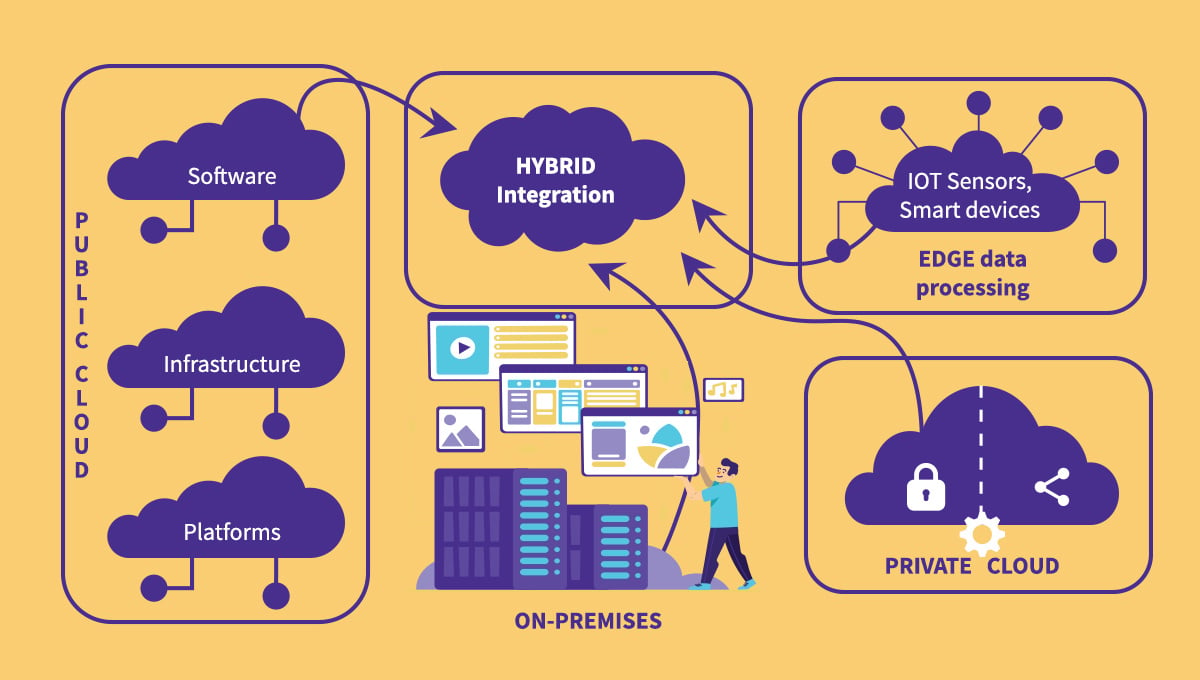
What is hybrid integration?
When two different animal species mate, their offspring is called a hybrid—a unique entity created from unlike sources. So, if you’re considering hybrid data integration, you already know you need to bring together some very different things.
Hybrid integration brings together data from diverse sources as a seamless unit, which may include any two or more of
- a company’s on-premises data center and systems,
- a company’s private cloud services,
- external, public third-party cloud services, and
- edge computing systems.
What is edge computing?
Edge computing refers to distributed IT systems that process data at the network’s periphery, nearer the source. It differs from traditional computing, which transports data to a central data center for processing.
How hybrid integration connects them all
Hybrid integration combines all the computing environments a firm may use into one source for consistent access to data and related processing workloads. Hybrid integration connects both the old and new.
The definition of hybrid integration is rapidly expanding—so these days, it may not include any on-premises system.
Gordon Haff of Red Hat Inc. explains that hybrid cloud systems envision architectures where “computing happens where it’s appropriate, and data flows where it’s best handled.”
Red Hat Inc., an IBM subsidiary that’s most often associated with the Linux open-source operating system, defines hybrid clouds this way:
“Hybrid clouds are multiple cloud environments with some workload portability, orchestration, and management among them.”
Today's top providers of hybrid cloud services are Amazon Web Services, Microsoft Azure, Google Cloud Platform, IBM Cloud, Oracle, VMware, Salesforce, and Alibaba. And there are many other key players, including Cisco Systems, Hewlett Packard Enterprise, and Workday.
(For a friendly explanation of the hybrid cloud, see the IBM Technology YouTube video on “What is Hybrid Cloud in 2o22.”)
Why might you need hybrid integration?
Each business is unique, with its own IT priorities. For some firms, doing their own IT in-house works just fine. For others, having their data transfer and processing done in the cloud works better. But many configurations have the best of both worlds—hybrid integration.
Here are five reasons for hybrid integration.
1. To save on modernization costs
For a firm that does not need to invest in enterprise-level remote IT infrastructure, hybrid data integration can be a good, cost-effective solution.
A surprising number of organizations still use old legacy systems to store and crunch their data. They want to modernize—but in stages, according to their needs, priorities, and budget.
Hybrid integration may be just the thing to keep access to the valuable information in their old systems while affordably accessing new remote apps and cloud services.
2. For security or company policy reasons
Regulated healthcare, insurance, and finance firms have sensitive data they prefer to manage on-site. Others may have strict compliance regulations requiring on-site, totally company-controlled data systems.
Such firms may want to use convenient cloud services for other data. A hybrid integration solution will work for them.
3. For the flexibility of using popular SaaS apps
Modern enterprise solutions are most often only available as SaaS or remote cloud services, requiring firms using only on-premises systems or their private cloud systems to invest in hybrid integration if they want to use those popular SaaS apps.
4. To speed up essential digitization to survive the pandemic
During the pandemic, many smaller businesses went under because they couldn’t do business on the internet. Or they weren’t able to convert to e-commerce fast enough.
With people working from home and the need to ramp up IT, HR, and e-commerce systems to survive this crisis, hybrid integration was a wise choice.
5. To prepare for the future.
The future is hybrid. Most enterprise-level IT is shifting from a centralized to a distributed model.
The typical large firm’s workloads, infrastructure, apps, and data are in multiple locations and environments. So, Hybrid Integration Platforms (HIPs) are on the rise.
A recent survey—the fourth global Enterprise Cloud Index—found that multi-cloud is here to stay. The international study spanned multiple industries, business sizes, and geographies—the 1,700 firms interviewed came from the Americas, Europe, the Middle East, and Africa.
The survey found that enterprise firms were most often using hybrid multi-cloud solutions. More than a third (36%) of enterprises surveyed said they used a multi-cloud IT model. Its use is expected to rise to 64% within one to three years.
Meanwhile, the figures are higher for large firms with over 5,000 employees. Fifty-six percent of those surveyed had already adopted multi-cloud, and 80% planned to do so in the next one to three years.
The survey found that 83% of all businesses believed hybrid multi-cloud was the ideal solution.
Why the increase in multi-cloud?
The survey found that the top use cases were:
- modernizing applications (53%)
- disaster recovery (51%)
- integrating with native cloud services like AI and machine learning (49%), and
- test and development agility (49%)

Data source: Fourth Annual Nutanix Global Enterprise Cloud Index, 2021.
HIPs are the future
Last year, Gartner estimated that the global cloud market would reach $482 billion in 2022. That figure refers to end-user spending on public cloud services. Hybrid Integration Platforms (HIPs) will most likely be forming the largest share of that market.
So, there are excellent reasons for hybrid integration. They are not only scalable, flexible, and fast—they’re here to stay.
If you are interested in hybrid integration, you may also be interested
in our blog: “7 Ways to Optimize Your Hybrid Integrations.” Do you ne
Phenom eCloud is a comprehensive technology solutions provider committed to empowering businesses to overcome challenges, enhance their workforce capabilities, and achieve superior outcomes.





Leave a Comment